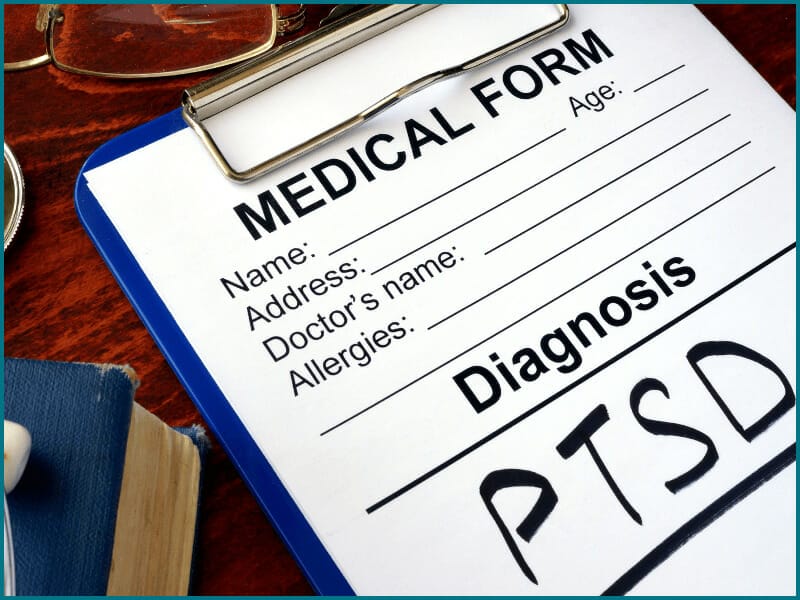Every day, millions worldwide grapple with Post-Traumatic Stress Disorder (PTSD), a debilitating condition that’s often misunderstood. If you’re reading this, chances are you’re seeking effective ways to cope with this disorder or help someone you know to navigate their PTSD journey. You’re in the right place.
This comprehensive guide delves into how Cognitive Behavioral Therapy (CBT), a well-researched, practical therapeutic approach, is used for PTSD recovery.
So, whether you’re a patient, caregiver, or just someone curious about mental health treatments, this article promises to be an insightful resource.
Understanding Post Traumatic Stress Disorder: A Quick Overview

PTSD is a psychiatric disorder that may occur in people who have experienced or witnessed a traumatic event such as:
- Natural disaster
- Serious accidents
- Terrorist acts
- War/combat
- Rape with the threat of death
- Sexual violence
- Severe injury
PTSD is not just about navigating through the aftermath of traumatic events. It’s a lasting consequence that can change one’s life, disrupting daily activities and relationships.
Common PTSD Symptoms and Signs
PTSD manifests differently in everyone, but there are several common symptoms that healthcare professionals look out for. Understanding these symptoms can help in early detection and treatment:
- Re-experiencing Trauma: This includes flashbacks, nightmares, or intrusive memories about the traumatic event.
- Avoidance: Efforts to avoid thoughts, feelings, or conversations related to the trauma.
- Negative Changes in Thoughts and Mood: This could be persistent negative emotions, detachment from others, or losing interest in previously enjoyable activities.
- Hyperarousal: Being constantly on guard, feeling jumpy, or experiencing difficulty sleeping and concentrating.
The Global Impact of PTSD
PTSD is a global concern, affecting a significant number of people across the world. To grasp its scale:
- An estimated 3.6% of the world’s population has had PTSD at some point.
- In the United States alone, approximately 8 million adults experience PTSD in a given year.
PTSD has wide-reaching implications, affecting not just the individuals suffering from it but their families, workplaces, and communities. That’s why understanding and effectively treating PTSD is crucial, and one of the leading methods used in treatment is Cognitive Behavioral Therapy (CBT).
Cognitive Behavioral Therapy (CBT): An Introduction

Cognitive Behavioral Therapy (CBT) is a type of psychotherapeutic treatment that helps individuals understand and change thought patterns that lead to harmful actions or distressing feelings. It’s grounded on the belief that our thoughts, rather than external factors, shape our emotions and behaviors.
The process of CBT revolves around working closely with a trained therapist in a structured way, typically during a limited number of sessions.
Here’s a general outline of what one can expect during CBT:
- Identification of problematic situations or conditions in your life: These might include, for example, symptoms of PTSD, medical conditions, grief, or issues in relationships.
- Becoming aware of your thoughts, emotions, and beliefs about these problems: Once you’ve identified the problematic situations, you and your therapist will observe your thoughts about them, including your self-talk and interpretations.
- Identification of negative or inaccurate thinking: To help with this, your therapist might encourage you to pay attention to your physical, emotional, and behavioral responses in different situations.
- Reshaping negative or inaccurate thinking: With the help of your therapist, you’ll learn to reframe these harmful or inaccurate thoughts, leading to more positive and beneficial actions.
Why CBT is Beneficial in Psychological Treatment
CBT has gained widespread acceptance and use in psychological treatment for several compelling reasons:
- Effectiveness: Studies have consistently shown CBT to be effective in treating various disorders, including PTSD, depression, anxiety disorders, and more.
- Adaptability: CBT can be tailored and adapted to fit the needs of each individual.
- Empowering: CBT equips individuals with coping skills that can be applied to current and future problems.
- Focused and Time-Limited: Typically, CBT requires less time investment than other forms of therapy might. It’s often considered more focused and goal-oriented.
CBT for PTSD: The Connection

Having grasped the basic concepts of PTSD and CBT, it’s crucial to understand the intersection between the two.
Why is CBT considered an effective treatment for PTSD, and how is it tailored to address this specific condition?
The Reasoning Behind Using CBT for PTSD
The nature of PTSD –– centered around recurring distressing thoughts, emotional discomfort, and avoidance behaviors –– makes it a fitting candidate for CBT. CBT’s fundamental principles revolve around understanding and altering thought patterns, which directly aligns with the needs of those managing PTSD.
Thus, individuals can learn to recognize and adjust the harmful thought patterns that drive their PTSD symptoms, reducing distress and improving their quality of life.
Tailoring CBT for PTSD Treatment
While CBT provides a general framework for therapy, it’s crucial to tailor the approach to address PTSD’s unique characteristics.
Here’s a brief overview of how CBT is adapted for PTSD:
- Assessment: A thorough evaluation of the individual’s history, symptoms, and needs.
- Psychoeducation: Teaching the individual about PTSD and the role of thoughts and behaviors in their symptoms.
- Skill Building: Introducing and practicing coping skills to manage symptoms and stress.
- Exposure: Helping individuals confront and process traumatic memories in a safe environment.
- Cognitive Restructuring: Challenging and altering harmful thought patterns related to the trauma.
- Relapse Prevention: Develop a plan to maintain progress and manage potential future stressors.
Components of CBT for PTSD
Several key components make up the CBT approach for PTSD, all of which work synergistically in the tailored application of CBT for PTSD.
- Exposure Therapy: This involves gradually and repeatedly being “exposed” to thoughts, feelings, and situations related to the trauma in a safe and controlled environment. The goal is to reduce the distress that these experiences cause over time.
- Cognitive Restructuring: This component helps individuals make sense of the trauma. It involves identifying, challenging, and changing distressing and unhelpful thoughts that have emerged due to the traumatic event.
- Stress Inoculation Training: This is a form of CBT where individuals learn techniques to reduce anxiety, such as breathing retraining and muscle relaxation. These skills can then be used during exposure to trauma reminders, reducing PTSD symptoms.
Why CBT Works for PTSD: The Science Behind

Understanding the science behind the effectiveness of CBT for PTSD helps underscore why this therapeutic approach is a go-to for many professionals in the mental health field.
Let’s delve into the scientific reasoning behind CBT’s effectiveness, focusing on the psychological and neurological changes this form of therapy brings.
The Psychological Reasoning
CBT is rooted in the premise that our thoughts influence our feelings and behaviors. When it comes to PTSD, individuals often harbor distressing thoughts or interpretations about their traumatic experiences, contributing to their symptoms. CBT, through its cognitive restructuring component, aids in identifying and reshaping these harmful thought patterns.
For instance, a person with PTSD might think, “The world is entirely unsafe.” This thought can lead to hypervigilance and avoidance of places that may trigger trauma reminders.
Working with a CBT therapist can challenge this thought, explore its accuracy, and learn to develop a more balanced perspective, such as “Some places can be dangerous, but many are safe.”
This process can decrease anxiety and avoidance, helping to alleviate PTSD symptoms.
The Neurological Changes
Research has shown that CBT can result in tangible neurological changes, further supporting its effectiveness for PTSD. Let’s look into these:
- Amygdala: This brain region plays a key role in fear responses and anxiety. Studies have shown that after CBT, individuals with PTSD can exhibit reduced amygdala activity, indicating decreased fear and anxiety responses.
- Prefrontal Cortex (PFC): The PFC is responsible for higher-order cognitive processes, like regulating emotional responses. CBT can increase the PFC’s ability to regulate the amygdala, thus promoting better control over fear and anxiety responses.
- Hippocampus: This part of the brain is involved in memory formation and retrieval. In PTSD, the hippocampus can be impaired. Still, studies suggest that CBT can result in increased hippocampal volume, which is associated with improved memory processing and a decrease in intrusive traumatic memories.
How to Access CBT for PTSD

Getting started with CBT for PTSD involves several steps. Here’s a general roadmap to guide you:
- Acknowledgment: Recognize your symptoms and accept the need for help. This is often the hardest yet most crucial step.
- Research: Understand what CBT is and how it can help you. Being well-informed empowers you to take an active role in your treatment.
- Professional Consultation: Reach out to a mental health professional for an evaluation. They can provide a diagnosis and discuss treatment options.
- Choosing a Therapist: Find a therapist who specializes in CBT and has experience in treating PTSD. The right therapist is key to a successful therapeutic relationship.
- Commencing Therapy: Begin your therapy sessions. Remember, recovery takes time and patience. Stay committed to the process.
The Importance of Seeking Professional Help
Mental health professionals can provide a proper diagnosis, guide you toward the most suitable treatment options, and offer a safe space to explore your experiences and feelings. They possess the skills and expertise to effectively deliver CBT, ensuring you reap the maximum benefits from this therapeutic approach.
Exploring Other Cognitive Therapy Techniques: Enhancing CBT for PTSD

When dealing with both acute and chronic PTSD, or Posttraumatic Stress Disorder, the umbrella of cognitive behavior therapy offers multiple paths to recovery. At Kinder in the Keys, we leverage several treatment modalities best to serve the individual needs of our PTSD patients.
These therapies, coupled with our primary focus on CBT for PTSD, enable us to deliver comprehensive care to our patients. By offering a range of trauma-focused treatments, we aim to cater to the diverse needs of those suffering from PTSD and guide them toward reclaiming their mental health.
Cognitive Processing Therapy
Cognitive Processing Therapy (CPT) is one of the techniques we employ. This trauma-focused psychological therapy is especially beneficial in treating anxiety-related disorders. CPT emphasizes understanding and modifying unhelpful beliefs related to the trauma narrative. By rewriting this narrative, individuals can learn to better cope with their symptoms and reactions.
Prolonged Exposure Therapy
Another valuable tool in our arsenal is Prolonged Exposure Therapy. This treatment is designed to help individuals gradually approach trauma-related memories and situations, reducing avoidance behavior.
By systematically confronting these experiences in a safe and controlled environment, patients can work towards overcoming their anxiety and distress.
Structured Writing Therapy
Structured Writing Therapy offers another avenue to process traumatic experiences. It involves writing about the trauma and helping individuals organize and understand their thoughts and feelings.
This method can contribute to the healing process by facilitating the release of deeply held emotions, significantly decreasing PTSD symptoms.
Take Control of Your Journey: Start Your CBT for PTSD with Kinder in the Keys Today
Pursuing CBT for PTSD at Kinder in the Keys could be your first step towards a healthier, happier life. As one of a handful of non-chemical dependency or dual diagnosis mental health facilities in the nation, we pride ourselves on our unique approach, focused on individual needs.
If you’re struggling with PTSD, it may be beneficial to seek help in treatment centers. Our skilled in administering CBT for PTSD, is on hand to help you navigate your thoughts and feelings, manage your symptoms, and ultimately steer you toward recovery.
Today could be the day you reclaim your mental health. Don’t hesitate to reach out to us and start your journey to healing.
